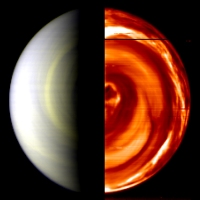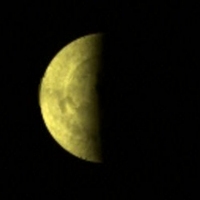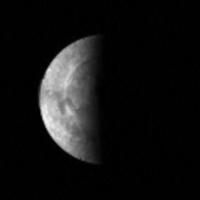First Images from Venus Express
13 April 2006
ESA's Venus Express has returned the first-ever images of the Venusian south pole, from a distance of 206 452 kilometres, showing surprisingly clear structures and unexpected detail. The images were taken 12 April during the spacecraft's initial capture orbit after successful arrival on 11 April 2006.Engineers have lost no time in switching on several of the instruments and yesterday the VMC (Venus Monitoring Camera) and VIRTIS (Visible and Infrared Thermal Imaging Spectrometer) imaged, for the first time in space history, the southern hemisphere of Venus as the spacecraft passed below the planet in an elliptical arc.
 |
|
VIRTIS composite image of the Venusian south pole |
The initial, low-quality images were taken from an extreme distance of 206 452 km from the planet, yet caught scientists' attention, particularly with the surprisingly clear structures and unexpected details shown in the VIRTIS spectrometer images.
The false-colour VIRTIS composite image shows Venus's day side on the left and night side on the right, and corresponds to a scale of 50 km per pixel.
The day half is itself a composite of images taken via wavelength filters and chiefly shows sunlight reflected from the tops of clouds, down to a height of about 65 km above the planet's surface.
The more spectacular night half, shown in reddish false colour, was taken via an infrared filter at a wavelength of 1.7 μm, and chiefly shows dynamic spiral cloud structures in the lower atmosphere, around 55 km altitude. The darker regions correspond to thicker cloud cover, while the brighter regions correspond to thinner cloud cover, allowing hot thermal radiation from lower down to be imaged.
The smaller VMC image shows Venus at a scale of 150 km per pixel and is also shown in false colour. It was recorded in ultraviolet.
 |
 |
|
VMC false colour image |
VMC greyscale image |
Venus Express fired its main engine to enter Venus orbit on 11 April 2006 and is now in the first 9-day capture orbit taking it to apocentre (maximum height) at 350 000 kilometres below the south pole. It will swing back up to pass pericentre (minimum height) at an altitude of 250 kilometres over the planet's north pole.
In the first capture orbit, Venus Express will have 5 additional opportunities for gathering data before reaching pericentre. These observations represent a great opportunity because, at apocentre, the full disc of Venus is fully visible for the spacecraft's imagers. Such opportunities will not occur again during the nominal mission, starting on 4 June 2006, when the range of distances from the planet will be much smaller.
In addition to VMC and VIRTIS, the spacecraft's MAG (Venus Express Magnetometer) has been switched on for initial verification and is operating nominally. Together with the ASPERA (Analyser of Space Plasma and Energetic Atoms), the two instruments are expected to gather information about the unperturbed solar wind and the atmospheric escape processes on Venus, a planet with no magnetic protection.
A series of further engine and thruster burns are planned to gradually reduce the apocentre during the following 16 orbits around the planet and the spacecraft is due to attain its final 24-hour polar orbit on 7 May.

